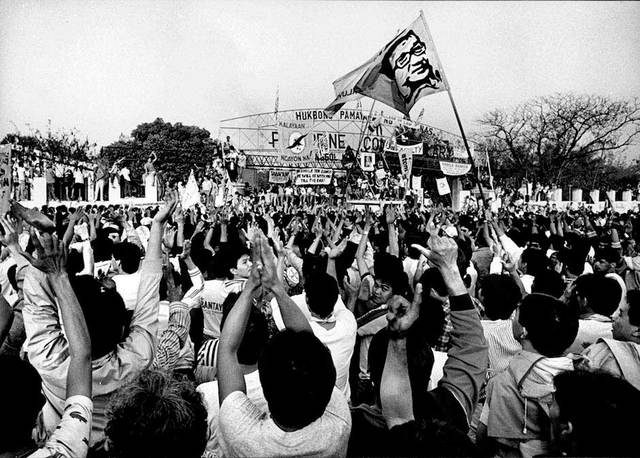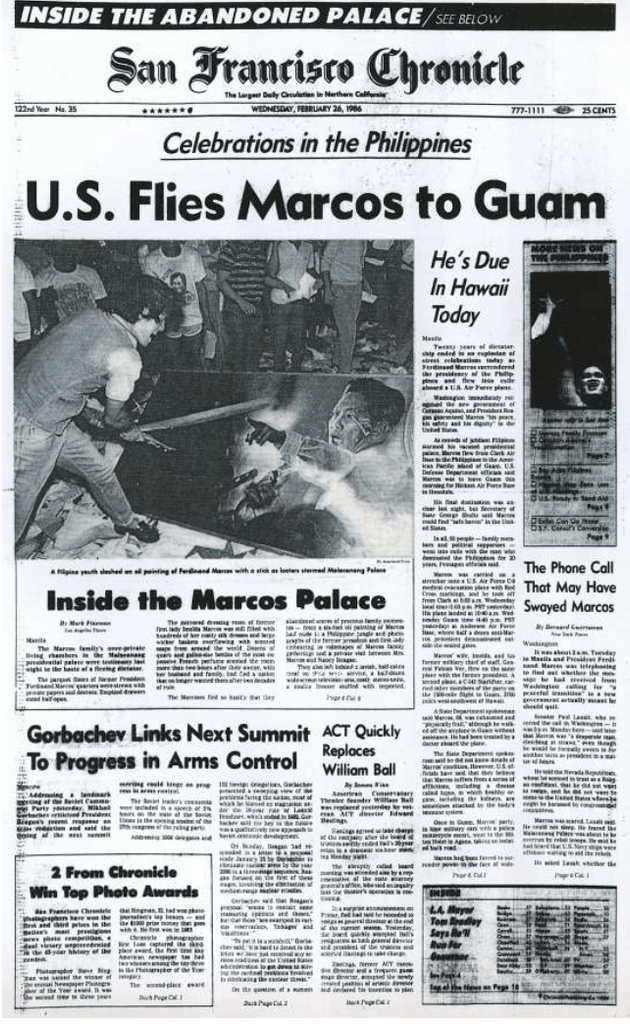SUMMARY
This is AI generated summarization, which may have errors. For context, always refer to the full article.

MANILA, Philippines – Thirty six years since a “bloodless revolution” in the Philippines ousted dictator Ferdinand Marcos, the legacy of People Power is fraught with danger. In recent years, memories of the pivotal period fade further from many Filipinos’ minds.
But reports from the ground in the days leading up to February 25, 1986 tell a different story – one where Filipinos showed the world that a peaceful uprising could topple military rule.
Under international spotlight, Filipinos earned widespread praise. World leaders at the time hailed the collective show of action after hundreds of thousands marched along the streets of EDSA to protest a fraudulent election. Marcos had claimed victory against the would-be president Corazon Aquino in an attempt to extend his grip on power – among the final blows to his 21-year rule. (IN PHOTOS: EDSA Revolution: Not just in 4 days)
As Marcos fled, scenes of thousands pouring into Malacañang Palace, where the public had not been allowed to enter for decades, filled the space of newspapers and airwaves in Manila and beyond. Now, Marcos’ son and namesake, Ferdinand “Bongbong” Marcos Jr., is seeking the presidency to reclaim his family’s power, pulling ahead of rivals two months away from the May 2022 polls.
Outside the Philippines, governments in Europe, Latin America, and Asia looked to People Power as displaying Filipinos’ “desire for freedom so strongly.” Challenging an unbending dictatorship, the People Power revolt went on to influence other popular uprisings not only in Asia, but also Eastern Europe and Africa. (READ: People Power legacy: What Myanmar’s protests can teach Filipinos)
Here’s what the 1986 People Power looked like to the rest of the world, from reporting in others countries’ leading news sources.
‘Finally free’

To mark the day Filipinos ushered a return to democracy, the New York Times bannered the headline “Marcos flees and is taken to Guam; US recognizes Aquino as President.” News of developments in the Philippines were told in four stories printed on its frontpage, and several more in the paper.
“Mr. Marcos, facing pressure from all sides to step down, left the presidential palace shortly after 9 P.M. (8 A.M. Eastern standard time) and traveled by helicopter to Clark Air Base,” the Times’ Seth Mydans reported.
The Marcos’ family’s departure capped a day during which the patriarch pleaded with the United States and influential Filipinos for help – to stay in power, or at least the country longer. While he held an inaugural ceremony at the Palace grounds, Marcos reportedly pleaded with Filipinos and American officials for some way to remain in office at least as “shell president” or “honorary president.”

Recalling Marcos’s response, Laxalt said the deposed president observed “the longest pause” and replied, “I am so very, very disappointed.”
Before leaving the Philippines, Marcos, according to a senior US State Department Official, asked Aquino’s supporters if he could instead return to his home in Ilocos Norte instead of going into exile. Marcos was quoted having been told it was not “practical.”
Aquino delivered a 52-second address on television, where she told Filipinos in celebration, “a new life starts for our country tomorrow.”
”We are finally free, and we can be truly proud of the unprecedented way in which we achieved our freedom, with courage, with determination, and most of all in peace,” she said.
Across the US, local newspapers also featured reports on the Philippines’ People Power. Withdrawal of support for Marcos from Washington had been among the pivotal factors that contributed to the end of his martial law.
The San Francisco Chronicle reported on how “Twenty years of dictatorship ended in an explosion of street celebrations today as Ferdinand Marcos surrendered the presidency of the Philippines and flew into exile aboard a U.S. Air Force plane.”

Recalling the moment in 2016, the Chronicle’s world wire editor Jack Epstein, said People Power was “the revolution that surprised the world.” “People Power ousted a dictator and ushered in a vibrant democracy that still exists in the Philippines today — in spite of rampant corruption,” he said.
Similar to the US, the United Kingdom’s The Guardian also featured Filipinos’ People Power. On February 25, 1986, the paper reported on how to the very end, Marcos had tried to “defy all attempts to unseat him.”

Promise, potential
Japan’s NHK had also aired a segment on People Power and how the end of Marcos’ decades-long rule brought the promise of potential to the Philippines.
In the region, Southeast Asian countries closely watched events unfolding. A spokesperson for Thailand’s foreign ministry at the time spoke of how the fall of Marcos “reflected the fact that politics in ASEAN countries is not like 15 or 20 years ago, when one man could dictate.”
The Times had likewise reported that newspaper editorials in Singapore, Hong Kong, Bangkok, Jakarta and Sydney, Australia which often reflected “official thinking” backed an end to Marcos’ rule in the Philippines.

The Associated Press (AP) put on record the worldwide welcoming of Philippine democracy, celebrated no less in capitals across the world.
In Tokyo, former foreign minister Shintaro Abe said Japan was pleased “that the recent tense stand-off in the Philippines has been resolved peacefully without the tragedy of bloodshed.” It joined hopes that Filipinos would unite behind a new government led by Aquino “and move ahead with the task of nation-building.″
From Singapore, the government led by then-prime minister Lee Kuan Yew and president Wee Kim Kee, viewed People Power as a moment to be proud of. “The Filipino people can take pride in overcoming a grave political crisis in a manner that does credit to democracy,” it said.

Similar congratulatory messages were sent from France, which said it “condemn[ed], as we have always done, dictatorship in any form and in particular when it takes a form called Marcos.”
In Washington, former secretary of state George Shultz spoke of how the Philippines’ new government “has been produced by one of the most stirring and courageous examples of the democratic process in modern history.”
“It is the Filipino people, of course, who are the true heroes today. They have high expectations for their country and for democracy, and they have resolved this issue nonviolently in a way that does them honor,” he said.
As messages continued to pour in, the AP took note of how “jubilant throngs of Filipinos set bonfires outside the palace.” The dispatch further read: as celebrations continued out on streets, a radio broadcaster announced “You’re hearing the start of the rebirth of democracy.” – Rappler.com

Add a comment
How does this make you feel?
![[EDITORIAL] Ito na ba ang huling EDSA?](https://www.rappler.com/tachyon/2022/02/animated-edsa-revolution-anniversary-2022-carousel.jpg?fit=449%2C449)
There are no comments yet. Add your comment to start the conversation.